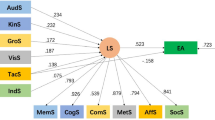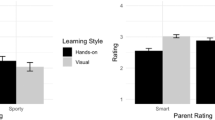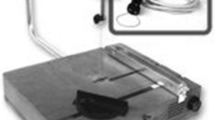Abstract
This paper aims to investigate the predictive validity of learning styles on academic achievement and technological literacy (TL). For this purpose, secondary school students were recruited (n = 150). An empirical research design was followed where the TL test was used with a learning style inventory measuring learning orientation, processing information, thinking, perceiving information, physical and time learning preferences, and sociological, emotional, and environmental learning preferences. Student performance was measured with grade point average (GPA) and TL level. Results show that 69 and 65 % of the variance in GPA and TL, respectively, can be explained by learning style predictors. Responsible and visual learning styles are the best positive predictors of GPA, while a reflective learner is the best negative predictor. Self-motivated and global learners are the best positive predictors of TL, while the need for authority figures and a theorist learning orientation are the best negative predictors of TL. The practical implications are that secondary schools should collect learning style data before helping students accordingly to be successful and more technologically literate. Highly conforming, global, and visual theorists might be offered more challenging tasks and special commendations on their projects, whereas more reflective and kinaesthetic students could receive more unstructured instruction in a busy environment with learning objects that incorporate innovative experiences, personalised information, and many associations. Assimilators need more textual material, more criterion-referenced instructions to achieve higher-order thinking learning objectives, more time to complete activities or assignments, more abstract problems, and unconstrained design conditions to improve their TL.

Similar content being viewed by others
References
Aljaberi, N. M. (2015). University students’ learning styles and their ability to solve mathematical problems. International Journal of Business and Social Science, 6(4), 152–165.
Allen, E., & Seaman, C. (2007). Likert scales and data analysis. Quality Progress, 47(7), 64–65.
Andreou, C., Papastavrou, E., & Merkouris, A. (2014). Learning styles and critical thinking relationship in baccalaureate nursing education: A systematic review. Nurse Education Today, 34(3), 362–371.
Avsec, S., & Jamšek, J. (2015). Technological literacy for students aged 6–18: A new method for holistic measuring of knowledge, capabilities, critical thinking and decision-making. International Journal of Technology and Design Education,. doi:10.1007/s10798-015-9299-y.
Avsec, S., & Szewczyk-Zakrzewska, A. (2015). How to provide better knowledge creation and diffusion in mechanical engineering: The DLSI as a vehicle. World Transactions on Engineering and Technology Education, 13(3), 280–285.
Baker, J. (2008). Exploring technological literacy: Middle school teachers’ perspectives. Unpublished doctoral thesis, Walden University.
Blunch, N. (2013). Introduction to structural equation modeling using SPSS and Amos. London: Sage.
Boyd, B. L., & Murphrey, T. P. (2004). Evaluating the scope of learning style instruments used in studies published in the journal of agricultural education. Journal of Southern Agricultural Education Research, 54(1), 124–133.
Carmo, L., Gomes, A., Pereira, F., & Mendes, A. (2006). Learning styles and problem solving strategies. Paper presented at the 3rd E-Learning Conference; 7–8 September 2006, Coimbra, Portugal.
Chase, M. W., Driscoll, L. G., Stewart, D. L., Hayhoe, C. R., & Leech, I. (2007). Exploring the relationship of first- year, first-semester college students’ mind styles and their consumer decision-making styles. Journal of Family and Consumer Sciences Education, 25(1), 10–23.
Cohen, J., Cohen, P., West, S. G., & Aiken, L. S. (2003). Applied multiple regression/correlation analysis for the behavioral sciences. Mahwah, NJ: Lawrence Erlbaum.
Cox, T. D. (2013). Learning styles and admission criteria as predictors of academic performance of college freshmen. Institute for Learning Styles Journal, 1, 1–10.
Dawes, J. (2008). Do data characteristics change according to the number of scale points used? An experiment using 5-point, 7-point and 10-point scales. International journal of market research, 50(1), 61–77.
De Miranda, M. (2004). The grounding of a discipline: Cognition and instruction in technology education. International Journal of Technology and Design Education, 14, 61–77.
de Vries, M. J. (2006). Technological knowledge and artifacts: An analytical view. In J. R. Dakers (Ed.), Defining technological literacy: Towards an epistemological framework (pp. 17–30). New York: Palgrave Macmillan.
Dunn, R. (1983). Learning style and its relation to exceptionality at both ends of the spectrum. Exceptional Children, 49(6), 496–506.
Dunn, R., & Dunn, K. (1989). Learning style inventory. Lawrence, KS: Price Systems.
Eisenkraft, A. (2010). Retrospective analysis of technological literacy of K-12 students in the USA. International Journal of Technology and Design Education, 20, 277–303.
Fatt, J. P. T., & Joo, N. T. (2001). Learning styles: Implications for design and technology education. Management Research News, 24(5), 24–37.
Fazarro, D., Pannkuk, T., Pavelock, D., & Hubbard, D. (2009). The effectiveness of instructional methods based on learning style preferences of agricultural students: A research tool for continuous improvement for faculty in career and technical education (CTE) programs. Journal of Industrial Teacher Education, 45(3), 84–104.
Felder, R. M. (1995). A longitudinal study of engineering student performance and retention. IV. Instructional methods and student responses to them. Journal of Engineering Education, 84(4), 361–367.
Felder, R. M., & Brent, R. (2005). Understanding student differences. Journal of Engineering Education, 94(1), 57–72.
Felder, R. M., & Silverman, L. K. (1988). Learning styles and teaching styles in engineering education. Engineering Education, 78(7), 674–681.
Felder, R. M., & Soloman, B. (2006). Learning styles and strategies. http://www4.ncsu.edu/unity/lockers/users/f/felder/public/ILSdir/styles.htm. Accessed 10 July 2015.
Felder, R. M., & Spurlin, J. E. (2005). Applications, reliability, and validity of the index of learning styles. International Journal of Engineering Education, 21(1), 103–112.
Forbes, N. S. (2008). A module to foster engineering creativity: An interpolative design problem and an extrapolative research project. Chemical Engineering Education, 42(4), 166–172.
Friedel, C. R., & Rudd, R. D. (2006). Creative thinking and learning styles in undergraduate agriculture students. Journal of Agricultural Education, 47(4), 102–111.
Galotti, K. M., Ciner, E., Altenbaumer, H. E., Geerts, H. J., Rupp, A., & Woulfe, J. (2006). Decision-making styles in a real-life decision: Choosing a college major. Personality and Individual Differences, 41, 629–639.
Garmire, E., & Pearson, G. (Eds.). (2006). Tech tally: Approaches to assessing technological literacy. Washington, DC: National Academies Press.
Gholami, S., & Bagheri, M. S. (2013). Relationship between VAK learning styles and problem solving styles regarding gender and students’ fields of study. Journal of Language Teaching and Research, 4(4), 700–706.
Gregorc, A. F. (2006). The mind styles model: Theory, principles and practice. Columbia, CT: AFG.
Halpern, D. F. (1996). Thought and knowledge: An introduction to critical thinking. Mahwah, NJ: Lawrence Erlbaum Associates, Publishers.
Hawk, T. F., & Shah, A. J. (2007). Using learning style instruments to enhance student learning. Decision Sciences Journal of Innovative Education, 5(1), 1–19.
Houtz, J. C., Selby, E., Esquivel, G. E., Okoye, R. A., Peters, K., & Treffinger, D. J. (2003). Creativity style and personality type. Creativity Research Journal, 15, 321–330.
International Technology and Engineering Education Association ITEEA. (2007). Standards for technological literacy: Content for the study of technology. Reston, VA: International Technology Education Association.
Kappe, R., & van der Flier, H. (2012). Predicting academic success in higher education: What’s more important than being smart? European Journal of Psychology of Education, 27(4), 605–619.
Karnofsky, H. (2014). Sequence thinking vs. cluster thinking. http://blog.givewell.org/2014/06/10/sequence-thinking-vs-cluster-thinking/. Accessed 6 June 2015.
Kaufman, S. B., Quilty, L. C., Grazioplene, R. G., Hirsh, J. B., Gray, J. R., Peterson, J. B., & De Young, C. G. (2015). Openness to experience and intellect differentially predict creative achievement in the arts and sciences. Journal of Personality,. doi:10.1111/jopy.12156.
Kirton, M. J. (1994). A theory of cognitive style. In M. J. Kirton (Ed.), Adaptors and innovators: Styles of creativity and problem-solving (pp. 1–33). London: Routledge.
Klapwijk, R., & Rommes, E. (2009). Career orientation of secondary school students (m/f)in the Netherlands. International Journal of Technology and Design Education, 19, 403–418.
Kolb, D. A. (1984). Experiential learning: Experience as the source of learning and development. Englewood Cliffs, NJ: Prentice Hall.
Kolb, A. Y., & Kolb, D. A. (2005). Learning styles and learning spaces: Enhancing experiential learning in higher education. Academy of Management Learning and Education, 4(2), 193–212.
Krathwohl, D. R. (2002). A revision of Bloom’s taxonomy: An overview. Theory into Practice, 41, 213–217.
Lee, D. (2008). Game theory and neural basis of social decision making. Nature Neuroscience, 11(4), 404–409.
Mohamad, M. M., Heong, Y. M., Rajuddin, M. R., & Keong, T. T. (2011). Identifying relationship involving learning styles and problem solving skills among vocational students. Journal of Technical Education and Training, 3(1), 37–45.
Moore, G., Raucent, B., Hernandez, A., Bourret, B., & Marre, D. (2005). What can teachers learn from what students say about PBL? In E. de Graaff, G. Saunders-Smits, & M. Nieweg (Eds.), Research and practice of active learning in engineering education (pp. 19–26). Amsterdam, NL: Amsterdam University Press.
Myers, B. E., & Dyer, J. E. (2006). The influence of student learning style on critical thinking skill. Journal of Agricultural Education, 47(1), 43–52.
Ogot, M., & Okudan, G. E. (2006). Systematic creativity methods in engineering education: A learning styles perspective. International Journal of Engineering Education, 22(3), 566–576.
Organization for Economic Co-operation and Development OECD. (2008). Encouraging student interest in science and technology studies. Paris: OECD.
Petrina, S. (2000). The politics of technological literacy. International Journal of Technology and Design Education, 10(2), 181–206.
Pintrich, P. R. (2002). The role of metacognitive knowledge in learning, teaching, and assessing. Theory Into Practice, 41(4), 219–225.
Powell, L. A. (2009). The role of learning styles in student evaluations of a problem-based learning course. Transformative Dialogues: Teaching and Learning Journal, 2(3), 1–15.
Richardson, M., Abraham, C., & Bond, R. (2012). Psychological correlates of university students’ academic performance: A systematic review and meta-analysis. Psychological Bulletin, 138(2), 353–387.
Rohaan, E. J., Taconis, R., & Jochems, W. M. G. (2010). Analysing teacher knowledge for technology education in primary schools. International Journal of Technology and Design Education,. doi:10.1007/s10798-010-9147-z.
Rossiter, J. R. (2011). Measurement for the social sciences: The C-OAR-SE method and why it must replace psychometrics. New York: Springer.
Rudd, R., Baker, M., & Hoover, T. (2000). Undergraduate agriculture student learning styles and critical thinking abilities: Is there a relationship. Journal of Agricultural Education, 41(3), 2–12.
Schermelleh-Engel, K., Moosbrugger, H., & Müller, H. (2003). Evaluating the fit of structural equation models: Tests of significance and descriptive goodness-of-fit measures. Methods of Psychological Research Online, 8(2), 23–74.
Schunn, C. D., & Silk, E. M. (2011). Learning theories for engineering and technology education. Fostering Human Development Through Engineering and Technology Education, International Technology Education Studies, 6, 3–18.
Sofo, F., Colapinto, C., Sofo, M., & Ammirato, S. (Eds.). (2013). Critical thinking and intellectual style. In Adaptive decision making and intellectual styles. Springer Briefs in Psychology (pp. 35–54). New York: Springer.
Tezel, E., & Casakin, H. (2010). Learning styles and students’ performance in design problem solving. ArchNet-IJAR International Journal of Architectural Research, 4, 262–277.
The Information Network on Education in Europe EURYDICE. (2014). The system of education in Poland. http://www.fss.org.pl/sites/fss.org.pl/files/the-system_2014_www.pdf. Accessed 15 August 2015.
Weir, J. P. (2005). Quantifying test-retest reliability using the intraclass correlation coefficient. Journal of Strength and Conditioning Research, 19(1), 231–240.
Wicklein, R. C. (2006). Five good reasons for engineering as the focus for technology education. The Technology Teacher, 65(7), 25–29.
Wilson, F. R., Pan, W., & Schumsky, D. A. (2012). Recalculation of the critical values for Lawshe’s content validity ratio. Measurement and Evaluation in Counseling and Development, 45(3), 197–210.
Acknowledgments
The authors wish to thank the Gimnazjum nr 6, Gimnazjum nr 22, VIII Liceum Ogólnokształcące, XX Liceum Ogólnokształcące, and the Pedagogy and Psychology Centre at Cracow University of Technology, Cracow, Poland, for their help in obtaining the valuable data for the research.
Author information
Authors and Affiliations
Corresponding author
Rights and permissions
About this article
Cite this article
Avsec, S., Szewczyk-Zakrzewska, A. Predicting academic success and technological literacy in secondary education: a learning styles perspective. Int J Technol Des Educ 27, 233–250 (2017). https://doi.org/10.1007/s10798-015-9344-x
Accepted:
Published:
Issue Date:
DOI: https://doi.org/10.1007/s10798-015-9344-x




